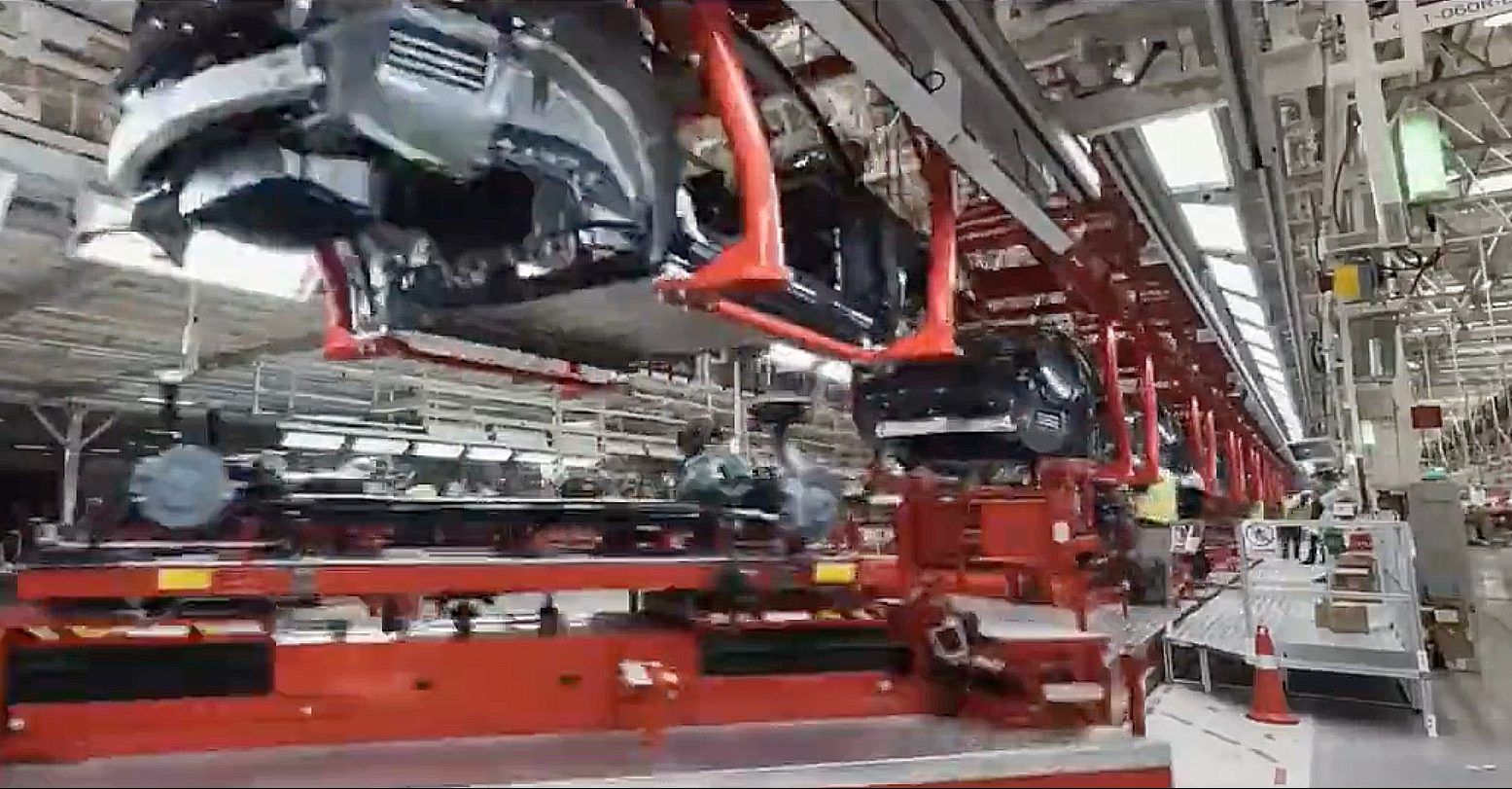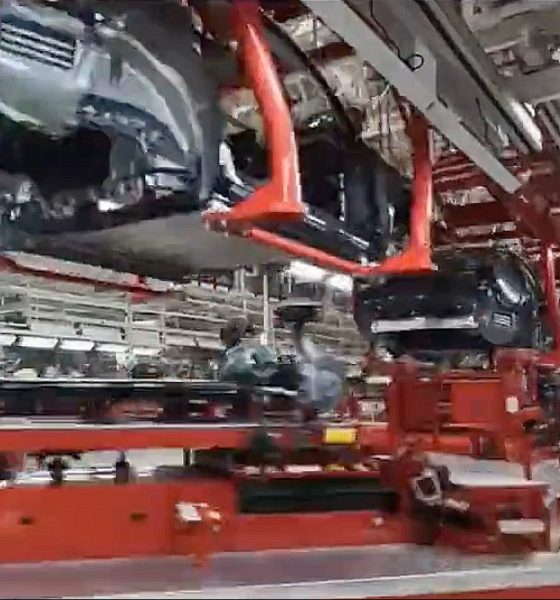

News
Tesla touts its Model Y ‘Alien Dreadnought’ production lines in China in new video
Tesla’s “Alien Dreadnought” Model Y lines at Gigafactory Shanghai in China are being touted in a new promotional video from the automaker released earlier today.
The video was posted by Tesla and shared by owner and enthusiast @Ray4Tesla on Twitter. Showing the numerous production processes of the Model Y crossover at the China plant, the video gives an idea of how automation is one of the key components of accurate, high-quality automotive manufacturing, which has surged Tesla into the stratosphere of China’s EV sector in recent years.
The newest promo video of Giga Shanghai, the “alien dreadnought” where machines build machines. @teslacn @elonmusk pic.twitter.com/O2H6OE9ZJO
— Ray4Tesla⚡️?☀️? (@ray4tesla) August 4, 2021
After beginning its project in China in early 2020 with the first deliveries of the Model 3, the Model Y followed closely after. By the end of 2020, Tesla had started the initial production of the Model Y in China. Deliveries began in early 2021, upon the initial exporting of Model 3 units to Europe. The Model Y has overtaken the Model 3 as Tesla’s most popular car, likely due to its similar build but more spacious interior and seating options due to its crossover body style.
In China, the Model Y has been high demand, and Tesla is focusing on its expansive expertise in manufacturing automation to keep up with rising order numbers. Tesla adopted highly automated lines several years ago at its Fremont Facility in Northern California. “Our internal code name for the factory, the machine that builds the machine, is the alien dreadnought,” Musk said on the call. “[When] our factory looks like an alien dreadnought, then we know it’s probably right,” Musk said. The idea to make manufacturing more dependent on automation came before the production of the Model 3 began in 2017. However, Tesla’s Fremont factory never attained a fully automated line as “production hell” made the company abandon the plans. However, the Shanghai factory appears to be adopting this style of manufacturing well as the video shows Tesla’s wide array of robots and automated machinery working to put together the company’s most sought-after car.
Giga Shanghai builds more than 450,000 vehicles per year, according to the company’s Installed Annual Capacity chart on the most recent Earnings Call Shareholder Deck. Between the Model 3 and Model Y, the automaker has solidified itself as one of the top automotive brands in China, only trailing the Wuling-SAIC-GM partnership that established the Wuling HongGuang Mini EV. The vehicles are not really comparable, as the HongGuang Mini EV starts at around $5,000 and does not come with standard features like power windows.
Tesla’s July delivery figures in China will likely be reported soon as the CPCA publishes the automaker’s data on a monthly basis. Tesla does not release its own delivery and production figures like other automakers.
Don’t hesitate to contact us with tips! Email us at tips@teslarati.com, or you can email me directly at joey@teslarati.com.

News
Tesla FSD fleet is nearing 7 billion total miles, including 2.5 billion city miles
As can be seen on Tesla’s official FSD webpage, vehicles equipped with the system have now navigated over 6.99 billion miles.

Tesla’s Full Self-Driving (Supervised) fleet is closing in on almost 7 billion total miles driven, as per data posted by the company on its official FSD webpage.
These figures hint at the massive scale of data fueling Tesla’s rapid FSD improvements, which have been quite notable as of late.
FSD mileage milestones
As can be seen on Tesla’s official FSD webpage, vehicles equipped with the system have now navigated over 6.99 billion miles. Tesla owner and avid FSD tester Whole Mars Catalog also shared a screenshot indicating that from the nearly 7 billion miles traveled by the FSD fleet, more than 2.5 billion miles were driven inside cities.
City miles are particularly valuable for complex urban scenarios like unprotected turns, pedestrian interactions, and traffic lights. This is also the difference-maker for FSD, as only complex solutions, such as Waymo’s self-driving taxis, operate similarly on inner-city streets. And even then, incidents such as the San Francisco blackouts have proven challenging for sensor-rich vehicles like Waymos.
Tesla’s data edge
Tesla has a number of advantages in the autonomous vehicle sector, one of which is the size of its fleet and the number of vehicles training FSD on real-world roads. Tesla’s nearly 7 billion FSD miles then allow the company to roll out updates that make its vehicles behave like they are being driven by experienced drivers, even if they are operating on their own.
So notable are Tesla’s improvements to FSD that NVIDIA Director of Robotics Jim Fan, after experiencing FSD v14, noted that the system is the first AI that passes what he described as a “Physical Turing Test.”
“Despite knowing exactly how robot learning works, I still find it magical watching the steering wheel turn by itself. First it feels surreal, next it becomes routine. Then, like the smartphone, taking it away actively hurts. This is how humanity gets rewired and glued to god-like technologies,” Fan wrote in a post on X.
News
Tesla starts showing how FSD will change lives in Europe
Local officials tested the system on narrow country roads and were impressed by FSD’s smooth, human-like driving, with some calling the service a game-changer for everyday life in areas that are far from urban centers.

Tesla has launched Europe’s first public shuttle service using Full Self-Driving (Supervised) in the rural Eifelkreis Bitburg-Prüm region of Germany, demonstrating how the technology can restore independence and mobility for people who struggle with limited transport options.
Local officials tested the system on narrow country roads and were impressed by FSD’s smooth, human-like driving, with some calling the service a game-changer for everyday life in areas that are far from urban centers.
Officials see real impact on rural residents
Arzfeld Mayor Johannes Kuhl and District Administrator Andreas Kruppert personally tested the Tesla shuttle service. This allowed them to see just how well FSD navigated winding lanes and rural roads confidently. Kruppert said, “Autonomous driving sounds like science fiction to many, but we simply see here that it works totally well in rural regions too.” Kuhl, for his part, also noted that FSD “feels like a very experienced driver.”
The pilot complements the area’s “Citizen Bus” program, which provides on-demand rides for elderly residents who can no longer drive themselves. Tesla Europe shared a video of a demonstration of the service, highlighting how FSD gives people their freedom back, even in places where public transport is not as prevalent.
What the Ministry for Economic Affairs and Transport says
Rhineland-Palatinate’s Minister Daniela Schmitt supported the project, praising the collaboration that made this “first of its kind in Europe” possible. As per the ministry, the rural rollout for the service shows FSD’s potential beyond major cities, and it delivers tangible benefits like grocery runs, doctor visits, and social connections for isolated residents.
“Reliable and flexible mobility is especially vital in rural areas. With the launch of a shuttle service using self-driving vehicles (FSD supervised) by Tesla in the Eifelkreis Bitburg-Prüm, an innovative pilot project is now getting underway that complements local community bus services. It is the first project of its kind in Europe.
“The result is a real gain for rural mobility: greater accessibility, more flexibility and tangible benefits for everyday life. A strong signal for innovation, cooperation and future-oriented mobility beyond urban centers,” the ministry wrote in a LinkedIn post.
News
Tesla China quietly posts Robotaxi-related job listing
Tesla China is currently seeking a Low Voltage Electrical Engineer to work on circuit board design for the company’s autonomous vehicles.

Tesla has posted a new job listing in Shanghai explicitly tied to its Robotaxi program, fueling speculation that the company is preparing to launch its dedicated autonomous ride-hailing service in China.
As noted in the listing, Tesla China is currently seeking a Low Voltage Electrical Engineer to work on circuit board design for the company’s autonomous vehicles.
Robotaxi-specific role
The listing, which was shared on social media platform X by industry watcher @tslaming, suggested that Tesla China is looking to fill the role urgently. The job listing itself specifically mentions that the person hired for the role will be working on the Low Voltage Hardware team, which would design the circuit boards that would serve as the nervous system of the Robotaxi.
Key tasks for the role, as indicated in the job listing, include collaboration with PCB layout, firmware, mechanical, program management, and validation teams, among other responsibilities. The role is based in Shanghai.
China Robotaxi launch
China represents a massive potential market for robotaxis, with its dense urban centers and supportive policies in select cities. Tesla has limited permission to roll out FSD in the country, though despite this, its vehicles have been hailed as among the best in the market when it comes to autonomous features. So far, at least, it appears that China supports Tesla’s FSD and Robotaxi rollout.
This was hinted at in November, when Tesla brought the Cybercab to the 8th China International Import Expo (CIIE) in Shanghai, marking the first time that the autonomous two-seater was brought to the Asia-Pacific region. The vehicle, despite not having a release date in China, received a significant amount of interest among the event’s attendees.








